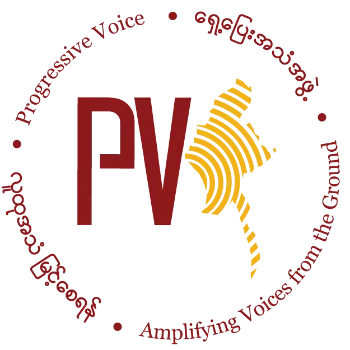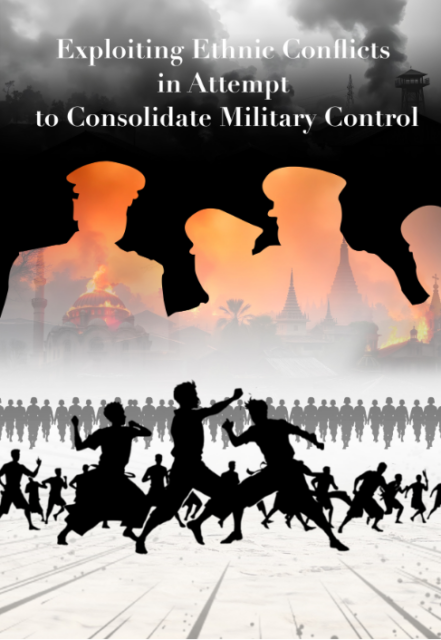Exploiting Ethnic Conflicts in Attempt to Consolidate Military Control
04 October 2024

Summary
The Three Brotherhood Alliance (3BHA) which comprises of the Myanmar National Democratic Alliance Army (MNDAA), the Arakan Army (AA), and the Ta’ang National Liberation Army (TNLA) launched assaults on junta bases and outposts in northern Shan on 27 October 2023, under the Operation 1027. It was found that the military, known to regularly ferment ethnic and religious conflicts in the past, accelerated disseminating hate speech and propaganda after Operation 1027 had contracted its controlled territories. Specifically, the junta and pro-military Telegram channels which promote its actions have intensified their dissemination of hate speech and propaganda materials with the intention of amplifying ethno-religious tensions in northern Shan and Rakhine.
As the 3BHA swiftly neutralized and captured territories in northern Shan, China was portrayed by pro-military telegram channels as being behind the Operation 1027. Moreover, the MNDAA’s attacks were depicted as an invasion by a Chinese ethnic group into the territory of Shan people. Following the commencement of Operation 1027, narratives claiming that foreign groups such as the Chinese and their ethnic groups, were invading Shan territories and oppressing the native Shan people gained prominence in the hate speech and propaganda spread by the junta.
Moreover, the junta was also found to be actively generating hostility by exploiting the existing tensions among Ethnic Revolutionary Organizations (EROs), including the MNDAA, TNLA, Kachin Independence Army (KIA), and (Shan State Progress Party (SSPP)/ Shan State Army (SSA). The junta also engendered antagonism between ethnic groups when the AA resumed its assaults on the military, capturing towns in Chin and Rakhine. Subsequently, the junta fomented discord between the AA and Chin people in Paletwa as well as spread disinformation which can cause the deterioration of inter-Chin relations. Similarly, pro-military telegram channels exacerbated existing ethnic and religious tensions and conflicts by portraying differences between northern and southern Rakhine and exploiting tensions between the Arakanese and other ethnic groups, particularly the Rohingyas.
In order to incite conflicts between Burmans and other ethnic groups, a narrative was propagated that ethnic revolutionary groups’ attacks targeted Burman-Buddhist. According to junta propaganda, MNDAA was reported to have prohibited Burmans from entering Laukkaing in northern Shan, outlawing the usage of Myanmar currency, and destroying the property of Burmans in the town. Additionally, a video of a person wearing MNDAA uniform smashing a Buddhist pagoda with a sledgehammer was shared widely on social media. In the face of this adversity, the junta’s propagandists promulgated the need for Burmans to stay united and encouraged counter actions such as taking revenge on Kokang people who had settled in Burman-dominated areas.
Similarly, disinformation claiming that the AA massacred family members of the junta soldiers fleeing from a sinking military vessel was also spread. Concurrently, military supporters called for the campaign “to boycott Rakhine monti and other Arakanese delicacies”, deliberately sowing the seed for Burman-Arakanese ethnic conflict. Ethnic Revolutionary Organizations were depicted as exploiting Burman-dominated People’s Defense Forces (PDFs) and bent on destroying Buddhism due to their hatred for it.
According to military propaganda, Burman-Buddhists were urged to knit together against their enemies as they were the primary target of Ethnic Revolutionary Organizations. Moreover, Buddhism-based propaganda campaign was initiated to preserve the nation, religion, and sovereignty. The loss of military outposts and territories due to the advancement of revolutionary forces was portrayed as having adverse effects on national security.
By highlighting ultra-Burmese nationalism and centralization ideology, the military was portrayed as an institution dedicated to protecting the nation, religion, and sovereignty, appealing the populace to support its actions. Meanwhile, Ethnic Revolutionary Organizations were depicted as furthering their own interests rather than those of the nation. This portrayal denigrated the actions of Ethnic Revolutionary Organizations and entrenched the military’s grip on power.
Announcements
21 May 2025
Open letter: Malaysia must lead ASEAN with principle, not hypocrisy, to address the Myanmar crisis

Progressive Voice is a participatory rights-based policy research and advocacy organization rooted in civil society, that maintains strong networks and relationships with grassroots organizations and community-based organizations throughout Myanmar. It acts as a bridge to the international community and international policymakers by amplifying voices from the ground, and advocating for a rights-based policy narrative.
